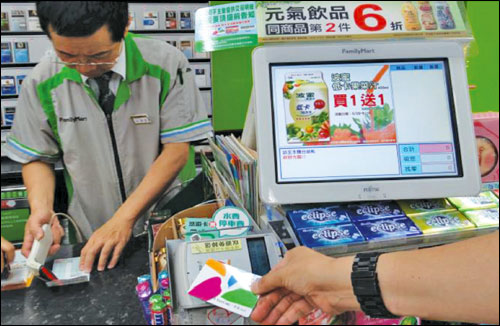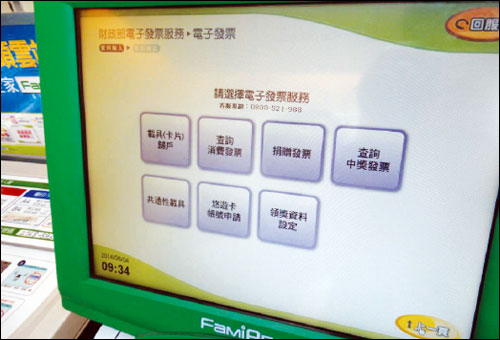In 2006, Taiwan set out to improve environmental conditions on the East Asia island. The state was issuing more than 8 billion paper invoices annually—the equivalent of 80,000 trees and 3,200 tons of CO2 emissions, according to the Taiwan Fiscal Information Agency (FIA), a division of the Ministry of Finance.
The FIA launched an electronic invoicing system for business-to-business transactions. The effort helped reduce paper consumption, but not nearly enough. So in May 2010, the FIA established a three-year project to encourage the use of electronic invoices in the consumer sector.

From the outset, the FIA determined that radio frequency identification technologies could provide a convenient and secure way for consumers to receive and access e-invoices, according to Su Chun-Jung, director-general of the FIA and the project leader. To enable electronic invoicing, the organization needed a mechanism to link an e-invoice to its recipient. The FIA introduced the concept of a “carrier”—in essence, an identifier that is used to “collect” e-invoices.
Many consumers were already using RFID-enabled EasyCards to pay for rides on the island’s Mass Rapid Transportation system and to purchase items in retail stores. (The EasyCard is based on NXP Seminconductors‘ Mifare contactless smart card technology.) Unlike ATM and credit cards, EasyCards are anonymous, so the FIA chose EasyCards as the carrier for e-invoicing, to reduce privacy concerns, Chun-Jung says. The agency determined that smartphones equipped with Near-Field Communication technology could also serve as carriers.
The FIA hired consulting firm PricewaterhouseCoopers (PwC) to design the e-invoicing process in physical retail channels and to help the agency establish strategies to promote the solution. The organization also brought in Trade-Van Information Service as the systems integrator, to implement the back-end system that would support e-invoicing.
Today, more than 25,000 convenience and retail stores have adopted the e-invoice solution, and the FIA expects that number will grow to more than 30,000 by the end of the year. Consumers that shop at brick-and-mortar stores can use their EasyCards to provide identification and associate their purchases with their e-invoices. They can also use their EasyCards to review their e-invoices at kiosks in convenience stores. (Taiwan has the highest density of convenience stores in the world, according to the FIA.) In addition, consumers can use their smartphones to receive e-invoices.
Making E-Invoicing Easy
The FIA set up a crossfunctional team with representatives from PwC and Trade-Van, as well as lawyers, researchers, system testers and marketing specialists. The team recognized that the success of the project rested on making the solution simple for both retailers and consumers.

Trade-Van developed an E-Invoice Integrated Service Platform that retailers could access through the Internet when processing e-invoices for customers. The cloud infrastructure includes three levels: Infrastructure as a Service (IaaS), Platform as a Service (PaaS) and Software as a Service (SaaS).
Each EasyCard is embedded with a unique number. During a transaction, the retailer simultaneously transmits the card number and e-invoice to the E-Invoice Platform. The customer can check an invoice at a kiosk by entering the number, so the process remains anonymous. Trade-Van performed a security risk analysis for the whole system. The platform has an ISO 27001 certification for information security management.
The team estimated that roughly 20,000 merchants would need to connect to the E-Invoice Platform and upload approximately 12 million e-invoices daily, so team members tested the solution to ensure the collected data was accurate and the system could handle all the data. Then they adapted the E-Invoice Platform to distribute loads among dozens of systems. Finally, they evaluated the usability of the solution.
The FIA selected several major retail chain stores to field-test the solution. It installed an RFID reader that operates with a point-of sale (POS) terminal at each store’s checkout counter, to record information from a carrier (either an EasyCard or NFC smartphone) and connect it with transaction data. The POS was equipped with a printer to print out paper-based invoices for customers who did not pay with a carrier. The pilots revealed several issues that the team addressed.
First, retail chain stores used different rules to represent the identity of RFID cards. That would mean people could not review all their e-invoices from different retailers at one kiosk. To solve this problem, the FIA defined rules to represent the identity of RFID cards.
Another issue involved the timing of uploading data to the E-Invoice Platform. Chain stores typically executed batch jobs to collect e-invoices from each register, but some retailers weren’t always able to connect to the Internet.
The FIA decided to allow retailers 48 hours to upload e-invoices to the E-Invoice Platform. To accommodate customers that might not want to wait that long to access their invoices, the FIA defined the E-Invoice Delivery Specifications in Physical Channels, to enable retailers to deliver e-invoices to customers’ smartphones via NFC.
To make it easier for retailers to communicate with the E-Invoice Platform, the FIA developed a “turnkey” program that merchants can install on their enterprise resource planning (ERP) or other back-end system. The program puts all e-invoice data into specified folders and uploads it into the E-Invoice Platform automatically. The FIA gives the turnkey software to businesses for free.
Because some retailers want to enhance existing POS applications or build mobile applications, the FIA also defined application programming interfaces (APIs) for developers to create customized systems.
Growing Acceptance
The e-invoicing project took two years to complete. When the FIA launched the system, it organized a promotion team that included marketing and IT specialists, as well as business consultants. As part of its efforts to build momentum for e-invoicing, this team developed programs to educate retail employees about e-invoicing.
“Transforming paper invoices to e-invoices is a change of consumer behavior,” Chun-Jung says. “We provide both face-to-face and online courses to employees of merchants adopting e-invoicing, to introduce the concept of e-invoice and [the] benefit of it.” The agency also prepared frequently asked questions and responses and provided this to merchants so their employees could troubleshoot any problems that might arise. Now, the FIA says, the system promotes itself.
The e-invoicing solution is meeting the FIA’s goals. Today, roughly 10 percent of Taiwan’s consumers opt for paperless invoices. Many stores have more than one kiosk where customers can use their EasyCards or smartphones to review their e-invoices.
The agency is now expanding the e-invoicing system to department stores, restaurants, transportation facilities and other retail venues. “In the near future,” Chun-Jung says, “we will work on implementing this system into virtual channels, such as online shopping websites.”

